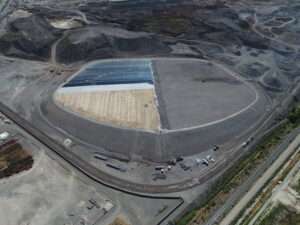Beneficial Reuse Gains Support in Industry
Date: Jul 17, 2025
In today’s evolving environmental landscape, beneficial reuse is gaining widespread attention across the environmental remediation and geotechnical construction industries. As sustainability, regulatory compliance, and cost control become more closely aligned, the idea of repurposing onsite materials is emerging as a practical, value-driven approach.
Once viewed primarily as waste to be managed or removed, these stabilized or treated environmental media are increasingly being recognized as resources that can be safely and effectively reintegrated into project sites. From reducing trucking and disposal costs to advancing measurable Environmental, Social and Governance (ESG) targets, beneficial reuse is no longer an optional sustainability feature, it is becoming an essential part of modern project delivery strategies.
Defining Beneficial Reuse
Beneficial reuse refers to the practice of repurposing environmental media generated during environmental or construction activities instead of disposing of them offsite. In the context of remediation and construction, this might include:
- Stabilized or treated soils reused as structural fill or subgrade material
- Treated groundwater used for dust suppression, soil conditioning, or irrigation under approved discharge permits
- Dredged sediments amended and incorporated into site grading, berm construction, industrial fill or habitat restoration areas
These practices reduce the impact of contaminated media, save money, and support project timelines, making them attractive to both public and private stakeholders.
Why Beneficial Reuse Is on the Rise
Several factors are driving this increased adoption of reuse strategies:
- Rising off-site disposal costs: Landfill availability is tightening, and haul distances are increasing. Transportation, tipping fees, and environmental compliance all contribute to higher total disposal costs.
- Stricter sustainability targets: Developers and industrial Clients are under pressure to reduce carbon footprints and demonstrate responsible material management through ESG initiatives.
- Regulatory changes: Agencies at both the state and federal levels are encouraging, or even requiring, reuse where safe and appropriate.
- Material shortages: In some regions, importing clean fill or other construction materials has become cost-prohibitive or logistically difficult. Reusing available onsite material is often the most reliable solution.
Regulatory Frameworks Are Evolving
State and federal regulators are acknowledging the value of beneficial reuse and issuing updated guidance to support its safe implementation. Several recent examples include:
- New York State Department of Environmental Conservation has proposed revisions to its Soil Cleanup Objectives, including new standards for PFAS (per- and polyfluoroalkyl substances) and clarified thresholds for reusing soils in redevelopment scenarios.
- Wisconsin Department of Natural Resources has released updated screening tools, including soil residual contaminant level calculators and risk-based guidance, to help practitioners assess reuse potential more efficiently.
- California continues to expand its sediment reuse protocols, especially for coastal and waterfront redevelopment and ecological restoration efforts. These updates promote adaptive sediment management and highlight safe opportunities for reuse.
At the federal level, the U.S. Environmental Protection Agency is reinforcing the importance of material reuse through evolving policies related to Resource Conservation Recovery Act (RCRA) corrective actions and Comprehensive Environmental Response Compensation Liability Act (CERCLA) remedial actions oversight. These regulatory programs support lifecycle material management, waste minimization, and proactive reuse strategies wherever feasible.
Sustainability Meets Cost Control
When considered during early project planning, beneficial reuse supports both environmental goals and bottom-line results. Reducing offsite disposal volumes leads to fewer truck trips, less fuel use, and decreased reliance on landfills. These outcomes contribute to immediate cost savings and lower overall carbon emissions.
Using onsite stabilized or treated environmental media instead of importing materials saves time and improves material efficiency. This approach not only shortens construction schedules but also supports regulatory and risk compliance and Client-driven sustainability targets. For organizations tracking carbon reductions or landfill diversion rates, reuse strategies provide clear, reportable metrics that align with ESG commitments.
Beneficial reuse also simplifies logistics. Fewer offsite waste streams and fewer incoming materials reduce coordination demands and make construction schedules more predictable. In an industry where schedule certainty and risk management are critical, reuse contributes to smoother execution and long-term value.
Why Clients Are Engaging ENTACT Early
As regulations evolve and project complexity increases, Clients and consultants are involving ENTACT earlier in the design and planning process to unlock beneficial reuse opportunities. Early engagement allows ENTACT’s technical teams to:
- Review soil and groundwater data
- Evaluate geotechnical and environmental performance parameters
- Align reuse options with grading, containment, and sequencing strategies
- Develop compliance pathways that satisfy environmental and permitting agencies
By considering beneficial reuse at the outset, ENTACT helps Clients avoid reactive redesigns and costly mid-project changes. This integrated approach streamlines both permitting and construction, allowing sustainability to work in the budget and schedule goals.
ENTACT brings decades of field experience and regulatory insight to every project. Whether working on industrial cleanups, coal ash closures, or large-scale redevelopment sites, the team identifies practical reuse strategies that are technically sound, environmentally responsible, and cost-effective.
The Future of Beneficial Reuse
As more Clients adopt formal sustainability frameworks, and more regulators offer clear pathways for reuse, the practice is evolving from niche to norm. What was once considered a value-add is quickly becoming a foundational element of current remediation and construction projects.
Looking ahead, beneficial reuse is expected to become more integrated with digital project planning tools, site modeling platforms, and material tracking systems. These technologies will help quantify benefits in real time, further supporting its widespread adoption.
For project owners and teams looking to balance environmental stewardship with efficient project delivery, beneficial reuse offers a clear path forward.


